John Butterworth, 1831 -
1900
by Brian Stevenson
last updated October, 2014
John
Butterworth was an amateur naturalist and maker of very high quality microscope slides of thin-sectioned coal fossils. He was largely self-taught, using
equipment he built by himself. He readily taught his skills to other naturalists - another highly regarded maker of coal fossil slides, James
Spencer (1834-1898), learned how to make sections from Butterworth. He also provided specimens to noted paleobotanists such as W.C. Williamson and Edward Binney. Butterworth was a Fellow of the Royal Microscopical Society, and member of the Literary and Philosophical Society of Manchester, The Manchester
Microscopical Society, and several other naturalists’ groups.
Considering
those many connections to the scholarly and wealthy classes, it is striking that
John Butterworth was self-educated and was relatively poor for most of his life. He labored in
the fabric mills near Manchester as a cotton carder, preparing raw cotton for
spinning into thread. A 1900 history of the Oldham Field Naturalists’ Society
wrote, “South-East Lancashire has earned
for itself a distinction during the last hundred years or so which more
favoured spots in this country, as far as social and natural advantages are
concerned, have failed to win, by reason of the appearance within its borders
of two indigenous growths of self-taught men characterised by more than
ordinary intellectual vigour, namely, a school of mathematicians and a school
of field-naturalists. The men belonging to these two schools have all been made
very much after one pattern. Nearly all of them have been poor and have had to
work hard for a daily pittance; yet they have managed to rise superior to their
circumstances, each having discovered for himself a potent virtue in learning
by means of which he has half forgotten his poverty, and has discovered a way
by which to transmute his lowly social position into something that brought
contentment and solace to his soul. Such were … John Butterworth, known as
‘Jack o' Ben's’, who as original thinkers and mathematicians were on a level with
high-classed wranglers of Cambridge”.
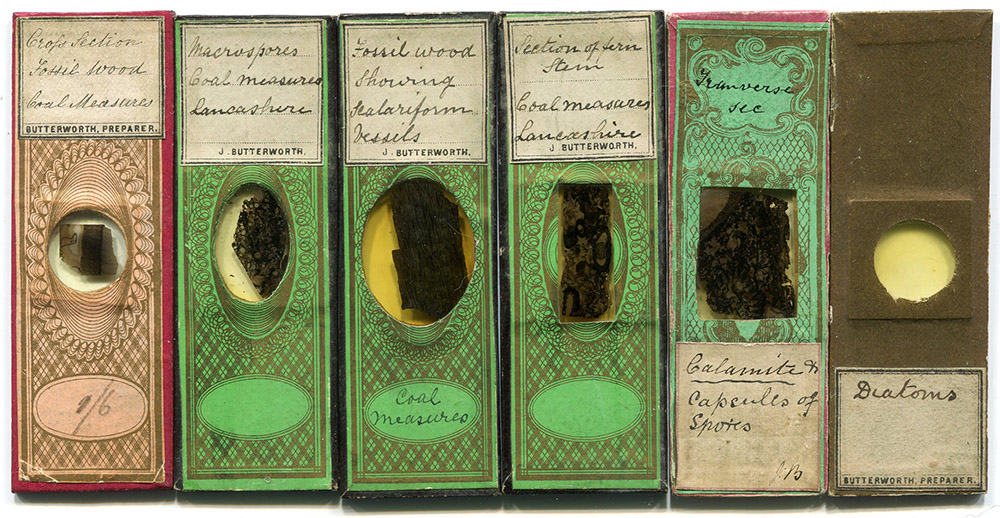
Figure 1.
Examples of microscope slides prepared by John Butterworth. The vast majority of his preparations are thin-sections of coal samples that bear botanical or other fossils. He did, however, mount other objects, such as the insect trachea and diatoms shown on the right. Most of his slides bear labels with his name set in type. Occasionally, slides are encountered with Butterworth's handwritten initials, such as the example shown second from the right.
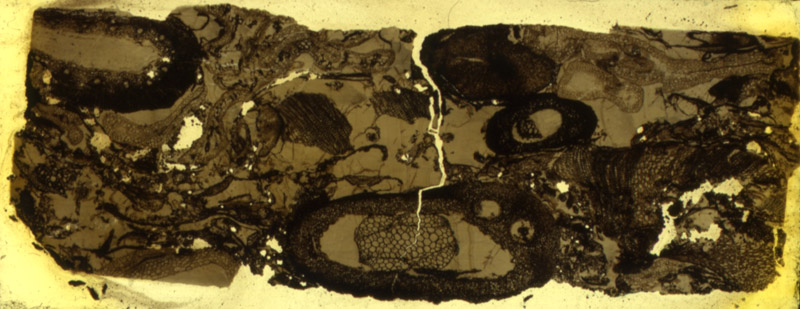
Figure 2.
Magnified view of the “Section of fern stem, Coal Measures, Lancashire” shown in Figure 1. Butterworth was adept at grinding fragile coal fossils down to remarkable thinness, permitting clear views of details.
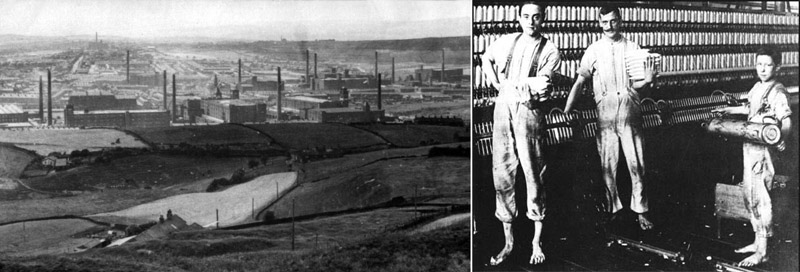
Figure 3.
Left, late 1800s view of cotton mills of Crompton,
among the places where John Butterworth lived and worked. Right, undated
photograph of workers in an Oldham cotton mill. Images reproduced for
educational, nonprofit purposes from (left)
http://en.wikipedia.org/wiki/List_of_mills_in_Shaw_and_Crompton#mediaviewer/File:Crompton_millscape.png
(public domain) and (right) http://spartacus-educational.com/IToldham.htm
Probably
born in early 1831, John Butterworth was baptized on May 1 of that year, at
Shaw Chapel, near Oldham, Lancashire. His father, George, was a carder in a
cotton mill, although, by 1851, he had risen to be a “manager over cotton spinning”. As would be expected of children
from his social class, the 1841 census recorded that 11 year-old John was already
working in the mills, as a “cotton piecer”.
His 14 year-old sister, Sarah, had the same job. The 1851 census listed John as
“carder of cotton”, while Sarah and
their 14 year-old brother were both “winders
of cotton”.
John
married Hannah Bromiley in 1858. W.C. Williamson wrote that Butterworth was an
“overlooker in a large cotton mill”
in the late 1860s, and he appears to have moved up the ranks to moderately
well-paid positions. Butterworth frequently changed his address, likely
indicating movement between several different cotton companies. Following the
Butterworth family through the English censuses, held every ten years, shows a
gradually improving financial status. The 1871 census lists 11 year-old
daughter Emma as being a “cardroom hand
in cotton mill”. In 1881, neither 19 year-old daughter Lizzie nor 11
year-old daughter Annie were recorded as being employed, and 17 year-old son
George was an “apprentice carder”
(Emma had married and moved away). Lizzie and Annie were still unmarried in
1891, yet neither had a job. The family evidently continued to live frugally,
living alongside other millworkers, and never having domestic servants. By the
time of his death, Butterworth had accumulated the sizeable estate of nearly
£3500, presumably acquired through mill employment, although it is possible he
sold fossil specimens.
Butterworth
became an expert on cotton, and on occasion lectured or wrote on the subject.
These included an 1875 talk that was reprinted in the USA by the New England
Cotton Manufacturers' Association, and the 1881 book Cotton and Its Treatment in the Various
Processes of Opening, Carding, and Spinning.
In
addition to cotton mills, Lancashire in Butterworth’s time had many coal mines.
Butterworth explored many of these, probably from childhood, and learned to
recognize fossil-bearing deposits. He wrote, in 1866, “The lower group of the Lancashire coal formation gives character to the
whole country round the borders of the basin, rising up in long low ranges of
green hills that flank the slopes of the Pennine chain; ‘and as they crop out’
on the hill-sides, or in the valleys, they are reached by a perpendicular shaft
of a few yards in depth only, or by horizontal openings, locally called ‘Breast
hees’. In the whole of this series there is, perhaps, no seam so easily
recognized as the ‘upper footmine’. Sharing, as it does, to some extent, the
family likeness common to the whole group - mineralogical composition and
identity of fossil remains, - it is yet quite unique in some of its features.
Most of the seams possess some peculiarity which distinguishes them from the
rest, and which serves the practical miner as a finger-post to guide him in his
labours. On none is the inscription more legibly written than on the foot-mine.
The feature that gives it its peculiarity is the great number of concretionary
masses, locally known as ‘bullions’, which are invariably associated with it.
Nodules are to be met with in greater or less abundance throughout the entire formation,
interspersed irregularly in the shale above the coal, while the bullions in the seam of which we speak, thickly stud
the roof, and in many cases press in and through the coal, to the great
detriment of the miner, turning him aside in his work of excavation, and in
some instances rendering his labour unremunerative. Indeed so serious a barrier
do they sometimes present, that he is often compelled to abandon the attempt to
recover the grimy treasure, and to leave it locked in the unyielding folds of the
‘safe’ where Nature had hoarded it untold ages ago. These nodules are of clay
iron-stone with a slight admixture of lime, and are so hard as to yield only to
repeated blows from a geological hammer of four or five pounds in weight. The
fossils they contain are Goniatites, Orthoceratites, Pectens, Mytilli, a few
Ferns, Calamites, fragments of fossil wood, &c. These stony remnants of
extinct organisms are in a good state of preservation, well defined in outline,
full and round in form as when they swarmed the estuaries or clothed the
verdant slopes and dense jungles of the Carboniferous period, in the full
enjoyment of that life which was meted to them by the great Creator”.
The
earliest published record to be located on Butterworth’s naturalist investigations
is an 1863 letter from Edward Binney to the Manchester Geological Society, “It is likely that I shall not be able to
attend the Meeting of the Geological Society to-morrow, therefore I beg to
forward you a box of remains of fossil fishes, consisting of Megalichthys, Helodus, &c, from
the roof of the Spanish Juice or Half-yard Mine at Carr Knol, near Oldham,
presented to the Society by Mr. John Butterworth, of Moorside, Oldham”.
At that
time, Butterworth was actively making microscope slides. The Intellectual Observer, in 1864, printed, “Lead Rings For Microscope Slides - Mr. John Butterworth, of Moorside, near Oldham, writes to us
that he cuts rings from lead tubes with a tenon Saw, and finds them answer very
well. Any inequality left by the saw can be removed by a file. Similar rings
could easily be punched out of sheet lead of various thicknesses, but they
would not be adapted for fluids, most of which would corrode them”.
He also
joined with several neighbors to form a microscopy club. He described this in
an 1865 letter to Hardwicke’s
Science-Gossip, “Circulating
Cabinet Of Objects - About six
months ago some microscopists in Oldham and its neighbourhood formed a circulating cabinet of objects. Not knowing that there is
anything of the sort in other towns, I will endeavour to describe it. In the
first place we have as many trays as there are members, upon which each member
puts six objects, in a horizontal position, held down by an elastic band. To
prevent one tray from touching the objects on another, a bead runs all round
each, about a quarter of an inch deep: the whole are enclosed in a box made for
the purpose. Each member changes the objects on his own tray every time the
cabinet comes round to him, and he retains it one week to examine the objects
on the other trays. A small memorandum-book, in which are written a few short
rules, the remaining space being left for remarks and suggestions, together
with a stamp-case, to receive the contributions of the members, which goes
along with the cabinet. The expenses of carriage, &c, are taken out of this
stamp-case. We find this arrangement to work very well, and have not had an
object broken yet. - John Butterworth”.
Butterworth dispersed specimens
and slides throughout the country. For examples, he published these exchange
offers in Hardwicke’s Science-Gossip: in 1867, “Fossil Wood in sections from Ashby de-la-Zouch -
Stamped envelope to J. Butterworth, 5, Bridgewater-street, Oldham”, in 1876, “Mounted
sections of fossil vegetable tissues from the Lancashire coal-measures in
exchange for good mounted objects. - J. Butterworth, Goats
Shaw, Oldham”, in 1879, “Transparent
sections from the coal formation showing macrospores, microspores, and other fossil vegetable tissues, in exchange for well-mounted
recent vegetable tissues, sections of leaves
stained or otherwise. - John Butterworth, Goats,
Shaw, near Oldham”, and 1880, “I have
the first vol. of ‘Grevillea’ in numbers that I wish to exchange for a copy of
‘Rust, Smut, Mildew, and Mould’, by Cook. I have also a large number of
selected specimens of fossil plants, showing internal structure, illustrating
the memoirs of Brongniart, Binney, Williamson, Carruthers, and others, which I
am wishful to exchange for small cabinets of about three or four trays to hold
about two or three dozen microscopic slides, or I would take cash. - John Butterworth, Goat's Shaw, near Oldham”. He also
mounted other types of specimen, as indicated by this 1880 exchange offer, “Foraminifera from the west coast of Ireland
(several species) clean and beautifully mounted in balsam, for interesting
mounted objects. - John Butterworth, Goat's Shaw, Oldham”.
Minutes of
the Oldham Microscopical Society include this, from 1869, “On Tuesday evening, October 12th, the quarterly meeting of this Society was held. There was a good attendance of members
and friends. A paper ‘On the Microscope in Geology’ was read by Mr. John Butterworth. After referring to the usefulness of
the microscope to students generally, Mr. Butterworth proceeded to state that by
its aid the geologist was enabled to trace the various phases of animal and
plant life existing through the different geologic ages, from the lowest
Silurian up to the present, and that the important discoveries made through its
agency have given a great impetus to, and interest in, the study of fossil
remains. Its use in ascertaining the characteristics of the crystalline,
stratified, and fossiliferous varieties of rock, was described at considerable
length, and illustrated by numerous beautifully-prepared specimens. The most
interesting part of the paper was that which treated of the fossiliferous
rocks, sections of which, from the Dudley limestone and from the Yoredale rocks
in the Hebden Valley, were exhibited, showing the internal structure of the corals,
zoophytes, goniatites, sponges, &c, of which they are composed. Special
attention was called to the fact that the coal-fields of Lancashire and
Yorkshire are remarkably rich in fossil plants and fish remains, and that in no
part perhaps were more interesting specimens to be met with than in and around
the town; some of which, gathered and prepared by various members, including
teeth and scales of fishes, coprolites, and fossil wood, were shown under the
microscope, by which the details of structure were brought out with remarkable
distinctness. Mr. Butterworth fully described the method by which sections for
the microscope may be cut and
prepared by the amateur at but little cost beyond time and patience. At the
close of the paper, an interesting discussion took place on the merits and
peculiarities of the various objects exhibited, which added greatly to the
information and interest of the meeting”.
Williamson
noted that Butterworth was “eminently
skilled in matters relating to machinery”, as a consequence of his work in
the cotton mills. Butterworth prepared fossil sections using a section
cutter/grinder of his own devising (Figure 4). He described this for Hardwicke’s Science-Gossip in 1869, “Having been asked by several readers of
Science-gossip how I cut and grind my sections of fossil wood, &c., I will,
with your permission, give my method. First, I will begin with the cutting. To
the framework of an ordinary foot-lathe I attach an upright spindle (see the
accompanying sketch); on this upright spindle I drive, by a band passing over
carry pulleys from the wheel below. On the top of this spindle I fix my cutting
disc, which is made from a very thin piece of sheet iron, and is about six
inches in diameter; the edge of this saw I charge with diamond powder; to the
edge of the saw I hold my specimen, and as it cuts I lubricate the edge with a
small brush dipped in turpentine. With this method I have cut sections of
fossil wood so thin that all its structure has been well defined and required
nothing but mounting in balsam: this has been silicated fossil wood; in cutting
calcareous fossil wood, I have to cut the sections thicker, and grind them
down. My grinding apparatus is composed of leaden laps, which I make to revolve
in a horizontal position on the same upright spindle on which I fix my cutting
saw; I use two laps, one for rough grinding, and the other for smoothing. I use
No. 1 emery and a little water with the first lap, and flour of emery with
plenty of water on the second lap. In preparing a specimen, I first grind a
smooth surface on one side, and then fix it to a plate of glass (of such a size
as will suit my specimen) with Canada balsam; I then reduce it in thickness on
the rough lap, till I begin to see the light through it; then I begin with the
smoothing lap, and reduce it with flour of emery until every part of its
structure is distinct. If I choose to polish the specimen, I do so on a lap
made of plush cloth, or cotton velvet, and putty powder; I then float them off
the slide on which they have been ground, and fix them on another with Canada
balsam. I prefer, were it practicable, to mount them in balsam under a thin
cover in the usual way, as I am satisfied that the structure is better brought
out. If any of the readers of the Gossip are similarly engaged, I shall be glad
to correspond with them on this subject.— John
Butterworth, Mount Pleasant, High Crompton, near Oldham”.
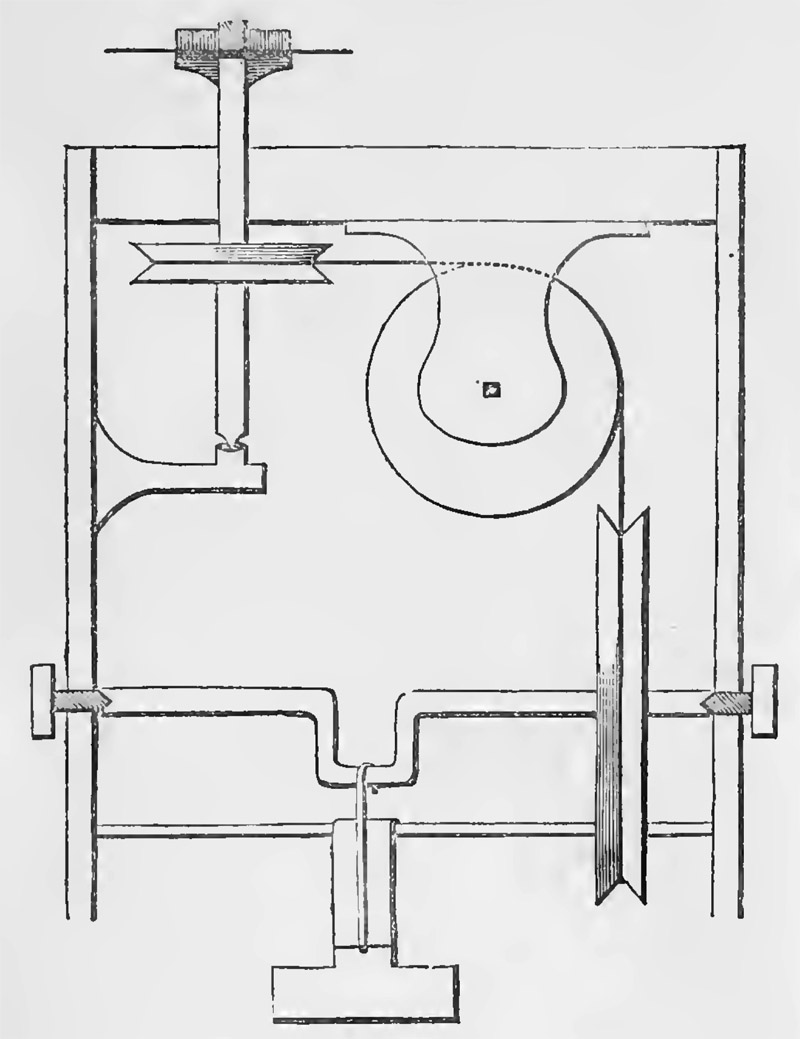
Figure 4.
Butterworth’s diagram of his section cutter/grinder,
which accompanied his 1869 article in ‘Hardwicke’s Science-Gossip’.
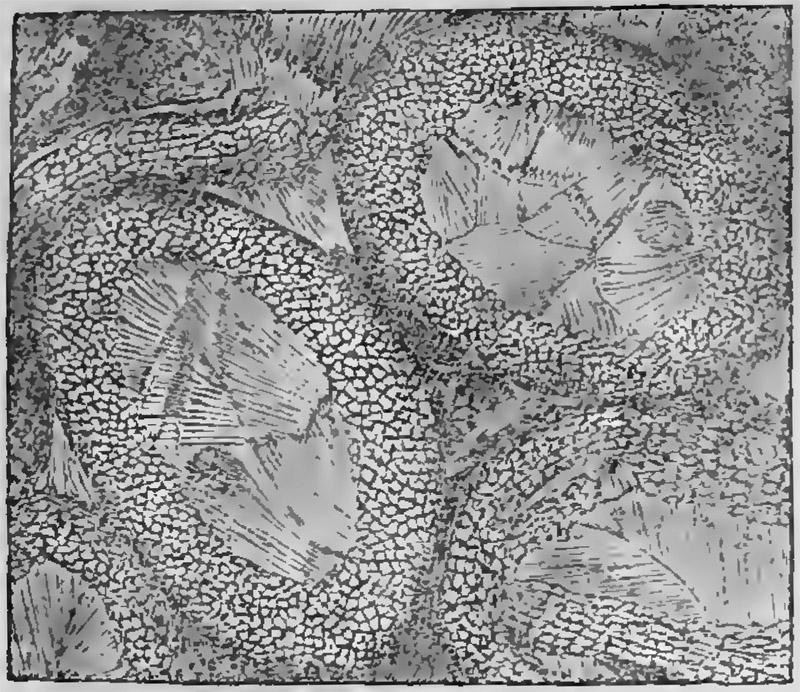
Figure 5.
Drawing of coal fossils, by John Butterworth, 1866.
He wrote that this “sketch represents one of the more humble forms, simple in
structure and decidedly endogenous. It is therefore possible, that, not only as
to species but as to genus, they have become quite extinct, and have left no
legitimate heirs to their wide estates. It is tolerably certain, however, that
they are allied to the more humble organisms of our present flora, - our reeds,
equisetums, ferns, lycopodiums, palms, and pines”.
Butterworth
made use of his cutting device to prepare thin sections of other materials. In
1865, Thomas Parry exhibited to the Literary and Philosophical Society of Manchester, “some sections of fossil wood and Echinus spines, most beautifully cut
by Mr. John Butterworth, of Oldham, and presented
some of the slides to the Section”. In 1874, Hardwicke’s Science-Gossip carried this exchange offer, “For beautiful Transparent Spines of Echinus sphaera, send stamped envelope and any Microscopic object of interest
to John Butterworth, Goats, Shaw, near Oldham”.
In a
similar vein, although Butterworth is best known for his work with botanical
fossils in coal, he prepared and studied other fossil types. For example, in
1869, he wrote, “In some coal shale I
have got from Bradford, near Manchester, I find … Entomostraca in great
abundance. A small portion of this shale, viewed under a low power as an opaque
object, shows what was once the horny case of these creatures in almost their
original form. If a section of this shale is ground very thin and mounted for
the microscope, the cases of the Entomostraca are
shown almost as transparent as glass. The same shale in which these Entomostraca occur at Bradford is also very full of fish remains,
for the most part in a very fragmentary state; and the fact of fish remains
being found in this state generally is held by several geologists to be caused
by the presence of these Entomostraca. In the shale above a small seam of coal
in this locality, locally known as the Little Mine, but better known to
geologists as the Lower Foot Coal-mine in the Ganister series, are found fish
remains identical with some of those found in Northumberland. I have cut
transparent sections of Coprolites from this Lower Foot coal, and they show
long and cross sections of Ganacrodus
hastulii (Owen), showing the beautiful point, which seems to be the only
part tipped with enamel. Cross sections of teeth that are scarcely visible to
the naked eye are also shown in these Coprolites. The dentine of the tooth,
with the pulp cavity in the centre is shown as distinct as if the section was
from one of the large Sauroid-fishes (of
course it requires the higher power of the microscope to see this). In the same Coprolite are also
shown sections of scales cut in various directions, as well as fragments of
bones, &c. Another Coprolite I have found in the shale above this little
coal-seam shows in a transparent section almost an entire mass of very small
scales, cut in almost every direction they show the markings on the scales most
splendidly”.
As noted
above, Butterworth supplied specimens to Binney, Williamson and other scholars,
and often featured prominently in their writings and lectures. Williamson
wrote, “I soon had the advantage of an
introduction to Mr. J. Butterworth of Shaw, near
Oldham, who had not only collected plants from the localities which had
supplied Mr. Binney with his, but had fitted up an excellent lapidary's lathe
and prepared some sections of the fossil plants, of which he showed me a small
but beautiful series. He also supplied me with a number of the hard calcareous
nodules dug out of the coal, from which these plants, the internal tissues of
which were so beautifully preserved, were obtained. .. Mr. Butterworth gave me
a section from a specimen which he had picked up, and which I at once saw had a
great interest; but his kindness did not stop here. On examining the fragment
not yet cut up, we determined upon the direction in which further sections
could advantageously be made, and which he undertook to make for me”.
Butterworth’s
specimens were also in demand from museums: W. Carruthers read the following
before the Royal Microscopical Society in 1872, “The beautiful series of specimens illustrating the structure of this
Lepidodendron have been recently obtained for the British Museum from the
valuable collection of Mr. John Butterworth, of
Shaw, near Oldham. Like my friend Professor Williamson, I have also to express
my great obligations to Mr. Butterworth for the
singularly instructive specimens which he has submitted to my examination.
Living as he does on the spot where the calcareous concretions, which have
supplied such valuable materials to recent workers, occur, imbued with a love
for the study of these ancient vegetable forms, and having an extensive and
accurate knowledge of their structure, and a quick eye for the parts in their structure which are yet only obscurely
known, Mr. Butterworth makes sections with his own
hands of carefully-selected materials, in a manner which renders them highly
instructive, and greatly facilitates the labour of interpretation and
description. The truth of these observations will be apparent by the series of
drawings accompanying this paper, made by Mr. Hollick from four slides
representing transverse and longitudinal sections of the stem and transverse sections
of the leaves close to and at a little distance from the stem. Of the numerous
figures that have been given by Witham, Lindley and Hutton, Brongniart, Binney,
and myself, none have shown the structure of the leaf bases, and their relation
to the stem, except that which I figured in my first communication to this
Society; but in that figure the single leaf was exhibited in one direction
only, and not with that completeness which, by the help of Mr. Butterworth's
specimens, I am now able to give”.
In addition to his contributions to the work of established
investigators, Butterworth played a critical role in the scientific development
of a younger coal fossil enthusiast, James Spencer. In an
1883 paper, Spencer reflected upon, “the first time that I met Mr. Butterworth. I was geologising at
Southowram Bank Top Coal Pit, near Halifax, one Saturday afternoon, when the
unusual sound of a fresh hammer attracted my attention. It proved to belong to
Mr. Butterworth; mutual explanation took place, and among the ‘spoils’ which we
won on that occasion was a good specimen of Lyginodendron Oldhamium. Since then many a pleasant ramble have
I enjoyed with my Oldham friends, both in Yorkshire and Lancashire, in search
of fossil plants”. A more complete story was provided in an 1899
memoriam of Spencer, “About 1871 Mr.
Spencer became especially interested in the study of the structure of fossil
plants which occur in nodules derived from the Halifax Hard Bed Coal. At first
he found this kind of work very difficult to perform, as he had to break the
petrified stems of plants out of the hard nodules, then chip thin pieces off
with a chisel, then rub them down on the sink-stone until they were so thin
light would shine through them. Then they had to be polished and mounted on
glass with Canada balsam before the structure could be seen to advantage with a
microscope. By this primitive and laborious method of preparing microscopic
slides of fossil wood, Mr. Spencer worked disadvantageously for some time. At
length he fortunately met with Mr. John Butterworth, of Shaw, near Oldham, who
was an adept at this kind of work, having been for several years engaged in
preparing and studying microscopic slides from the coal-balls of Lancashire.
This gentleman kindly and unhesitatingly agreed to show him a more scientific
and quicker method of preparing his slides, and he helped him to set up a
machine for cutting and grinding. He also gave him instructions in the art of
polishing, mounting and preparing specimens for scientific use. Thus equipped,
Mr. Spencer set to work with a determination to do something in the comparatively new field of research”.
Butterworth and several colleagues formed The Lancashire and Yorkshire Palaeobotanical Society in September, 1893. Butterworth was the first President of the club, which also included James Lomax, George Wild, Thomas Hick, William Cash, Thomas Mitchell, and M.M. Buckley. James Spencer, John Binns, and Isaac Earnshaw joined shortly afterward. The group met at various member's homes, exhibiting and exchanging samples, and presenting scientific discussions.
John Butterworth was elected as a Fellow of the Royal Microscopical Society on December 12, 1883. He made at least one trip to London in order to attend an
RMS meeting. On October 21, 1896, he read a paper on his “Photomicrographic Camera, designed chiefly to facilitate the study of opaque objects, more
especially in the study of palaeo-botany”:
“In drawing the attention of the Society to this camera, I do not do so with any idea that any of its parts may be in any way original. My wish is to draw attention to its application to both opaque and transparent objects in photomicrography. It was, however, with a view to adapting the camera to photographing opaque objects that first led me to experiment in photomicrography, and I have long seen that a wide field is open to photography in this direction; in illustration of this I may instance my own study of 'The Fossilised Plants of the Lancashire and Yorkshire Coalfields.' Having been engaged in this study for nearly thirty-five years, most of which time I have been a colleague of the late Prof. W.C. Williamson, and as such I have seen not a little of the difficulty of sketching by hand the
structure of these coal plants with a view to their description, and yet I can vouch for the great accuracy of the above gentleman's drawings, knowing as I
did his method of procedure, which was by aid of the camera lucida, micrometer, and paper ruled to scale.
Up to the advent of isochromatic photographic dry
plates and the use of colour screens it had always been a very great difficulty
to get a good photograph from sections of coal plants, owing to the amber
colour of the section, and, though the difficulty of the colour is to some
extent removed by the use of the above plates, still the section has to be ground
so thin to give it sufficient transparency that many important features of the
plant structure are often destroyed. It will therefore be readily seen that if
I cut a section of one of the calcareous nodules containing our coal plants,
and cut the section say 1/8 in. thick (which is not too thick considering the
nodules are calcareous), polishing both sides and fixing one side to a glass
slip as I shall show you, I can grind down the section slowly; and at various
stages, by my plan of photographing opaque objects, I can get at least six
photographs, each perhaps exhibiting features different to the rest, besides
leaving me a transparent section for microscopic examination. It will thus be
seen that these coal plants can be more fully studied by this plan, even from
very fragmentary material, which is often the condition in which many of the
coal plants are found.
Of my camera I need to say very little; its
construction will be readily understood from the appended plate (Figure
6). It has been built up piecemeal, but
has absorbed much of my leisure for several years. I can use a range of powers
from a 5-in. rectilinear lens down to my 1-in. microscopic objective for opaque
photography, and in photographing transparent objects I can use my microscopic
objectives from 4 in. down to a 1/16. The view shows the light as transmitted
to an opaque object when the argand or incandescent burner (which I now use) is
raised to its proper height, and when the burner and condenser are lowered to
throw the light direct through the object; it is then fixed for transparencies.
I thought it might be necessary to bring a few
lantern slides and a few slides of sections in various stages of preparation to
further illustrate our subject, and if any gentleman would like to ask any question
on the slides or the camera I shall be most pleased to give further
information.
P.S. - I may just add that the stage or object-holder
to the camera is so constructed at the back as to receive or hold all the
substage appliances that I have for my large Microscope, which
I have often used as occasion has required.*
* I ought to have made the remark in my paper that in
preparing sections of our coal plants each plane or surface intended to be
photographed ought to be first ground to a smooth surface and then flooded with
a few drops of dilute hydrochloric acid (1 part in 6 parts water), and when the
effervescence ceases wash and dry the section, which is then ready to expose in
the camera. This procedure is essential to show up the structure with the boldness
that is shown by the view”.
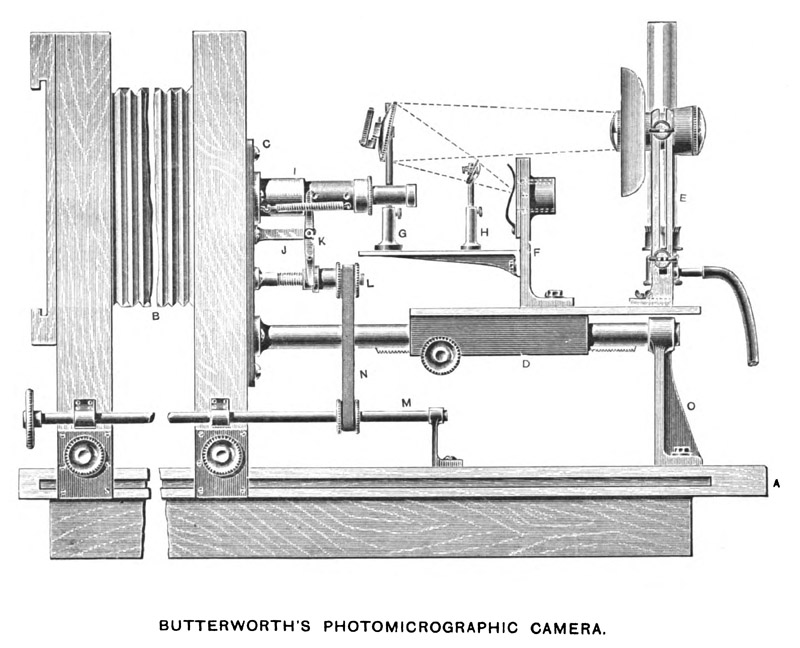
Figure 6.
Butterworth’s illustration of his camera. He
described it thusly, “A is the base-board of camera. B, bellows of usual form
and size. C is the foundation-plate, screwed to camera-front, carrying the
lens-tube, horizontal bar, rack, &c. D is the carriage, carrying lamp E, object-stage F, concave reflector G,
and small bull's-eye reflector H. I is the main lens-tube carrying adapters or
other tubes to suit battery of lenses. J is a bracket carrying a double-forked
lever K for fine focusing, which is actuated by the threaded pulley working on
the long screw L, while said pulley is revolved by the small side-shaft M
through the belt N. O is a support for the outer end of the horizontal bar. The
dotted lines show the path the fight takes on its way from the bull's-eye
condenser of lamp to the object”.
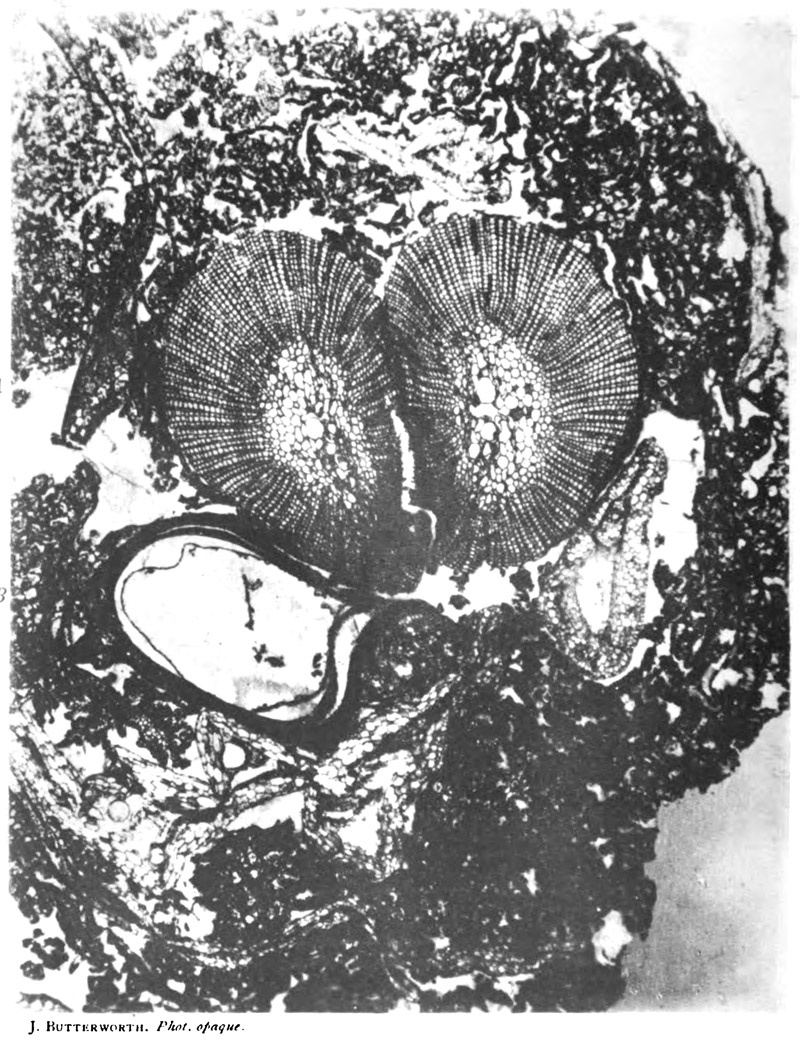
Figure 7.
An 1896 photograph by John Butterworth that accompanied the description of his camera, described as “Transverse section of Astromyelon cut at the fork where the plant was branching; also a transverse section of Cardiocarpon is shown lying near; from the lower coal measures near Oldham, x about 15 diameters. Photographed opaque”.
John Butterworth died at his home, 122 Rochdale Road, Shaw, on June 12, 1900. The Transactions of the Manchester Microscopical Society reported, "Amongst those whom death has removed during the past year, mention may be made of the late Mr. John Butterworth, of Shaw. He was for many years an earnest worker on the microscopic structure of the fossil plants of the coal measures, and latterly devoted attention to the construction of apparatus connected with photo-micrography".
Acknowledgements
Many thanks to Howard Lynk for his continued generosity.
Resources
Baptism record of John Butterworth (1831) accessed through
The Lancashire Open Parish Clerk Project, http://www.lan-opc.org.uk
Binney, E.W. (1871) “Fig.
1 is a fragment of a Cone, one and eight tenths of an inch in length, one and
one tenth of an inch across its major, and one inch across its minor axis. This
Cone is somewhat compressed out of its original cylindrical form, but not so
much as is the Specimen No. 17. The fossil has lost
the upper portions of the scales or bracts, in shelling out of its matrix, but
it shows the rhomboidal scars of Lepidostrobus. They are not so broad as those
of the last-described specimen. It also came from the Upper Foot Coal, near Oldham, and was found by Mr. John
Butterworth, who has liberally allowed me to slice and describe it”,
Observations on the Structure of Fossil
Plants Found in the Carboniferous Strata, Part 2, Palaeontographical
Society, London, page 49
Bracegirdle, Brian (1998) Microscopical Mounts and Mounters, Quekett Microscopical Club,
pages 19 and 118, plate 7-N and 7-O
Butterworth, John (1865) Circulating cabinet of objects, Hardwicke’s Science-Gossip, Vol. 1, page 237
Butterworth, John (1866) Fossil wood, Hardwicke’s Science-Gossip, Vol. 2, pages 250-251
Butterworth, John (1866) Sections of fossil wood, Hardwicke’s Science-Gossip, Vol. 5, page 18
Butterworth, John (1866) Entomostraca in shale, Hardwicke’s Science-Gossip, Vol. 5, pages 111-112
Butterworth, John (1875) Lecture on Cotton, Publications of The New England Cotton
Manufacturers' Association, pages 49-45
Butterworth, John (1876) Rambles after fossil plants, Hardwicke’s Science-Gossip, Vol. 12, pages 243-244
Butterworth, John (1880) The mineralisation of coal plants, Hardwicke’s Science-Gossip, Vol. 16, pages 162-163
Butterworth, John (1881) Cotton and Its Treatment in the Various Processes of Opening, Carding, and Spinning, Hirst & Rennie, Oldham
Butterworth, John (1889) Calcareous nodule from coal, Journal of Microscopy and Natural Science,
Vol. 8, page 251
Butterworth, John (1889) Photomicrographic camera, designed chiefly to facilitate the study of
opaque objects, more especially in the study of palaeo-botany, Journal of Microscopy, pages 595-596
Carruthers, W. (1872) On the structure of the stems of
the arborescent Lycopodaceae of the Coal-measures, and On
a leaf-bearing branch of a species of Lepidodendron, Monthly Microscopical Journal, Vol. 7, pages 50-54
Chemical News (1866)
Minutes of the December 18, 1865 meeting of the Microscopical and Natural
History Section of the Literary and Philosophical Society
Manchester, page 21
England census, birth, marriage and death records, accessed
through ancestry.co.uk
English Mechanic and World of Science (1871) “Coal Plants - Mr. J. Butterworth writes as follows to the Monthly Microscopical Journal: - ‘It will be remembered that Professor Williamson read a memoir some time ago, before the Manchester Philosophical Society, on a new fossil fruit found by me in one of the lower coal-seams of
the Lancashire Coal-field: this fruit he described as belonging to his new plant called Calamopetus. Since then he has read another memoir before the above society on another but very different fossil fruit found by me in the same coal-seam. I have been very fortunate in finding another coal fruit, very different from either of the above. The sporangia in the two first fruits are protected by bracts, which pass between the sporangia from the axes. When they reach the outside, they ascend and overlap each other, is seen in Lepidostrobus. This fruit I have just found seems to be void of these bracts altogether, and appears to be a naked cone. The spores are those of a Calamite, and the sporangia are very numerous and densely packed together.’ - Our readers should obtain specimens of coal fossils for examination with the microscope, as we believe there are many facts that may yet be discovered with respect to our coal formations”, Vol. 13, page 380
English Mechanic and World of Science (1900) “Mr. John Butterworth, F.R.M.S., was well known throughout
Lancashire for his knowledge of all the minutiae of cotton-spinning, but he was
also known for his work on scientific subjects, especially in connection with
the fossilised plants of the Lancashire and Yorkshire coalfields. He was a
member of the Manchester Literary and Philosophical Society, and devised a photomicrographic camera for
the purpose of studying opaque objects. He was a colleague of the late Prof. W.
C. Williamson. Mr. Butterworth, who resided at Shaw, was in his 70th year”, Vol. 71, page 400
Hardwicke’s Science-Gossip (1867) Exchange offer from J. Butterworth, Vol. 3, page 120
Hardwicke’s Science-Gossip (1867)
Response to query: “Witham’s Books – Mr. John Butterworth may procure either of Witham’s works of Mr. E.D. Suter, 37, Cheapside, London”, Vol. 3, page 168
Hardwicke’s Science-Gossip (1873)
Exchange offer from J. Butterworth, Vol. 9, page 43
Hardwicke’s Science-Gossip (1874)
Exchange offer from J. Butterworth, Vol. 10, page 72
Hardwicke’s Science-Gossip (1876)
Exchange offer from J. Butterworth, Vol. 12, page 240
Hardwicke’s Science-Gossip (1879)
Exchange offer from J. Butterworth, Vol. 15, page 192
Hardwicke’s Science-Gossip (1880)
Exchange offers from J. Butterworth, Vol. 16, pages 48 and 120
Hardwicke’s Science-Gossip (1893)
Exchange offer from J. Butterworth, Vol. 29, page 48
Howell, A.C. (2005) James Lomax (1857-1934): palaeobotanical catalyst or hindrance?, in History of Palaeobotany: Selected Essays, edited by A. J. Bowden, C. V. Burek, and R. Wilding, Geological Society, Bath, U.K., pages 137-152
The Intellectual Observer (1864)
Lead rings for microscope slides, Vol. 5, page 66
Journal of the Royal
Microscopical Society (1883) Election of new Fellows, December 12, 1883,
Vol. 4, page 163
Law, Robert (1899) In memoriam – James Spencer, Proceedings of the Yorkshire Geological and Polytechnic Society, Vol. 13, page 475
Manchester Microscopical Society: Transactions and Annual Report for 1900 (1901) page 8
The Monthly Microscopical Journal (1869) Minutes of the October 12 meeting of the Oldham Microscopical Society, pages 287-288
The Monthly Microscopical Journal (1873) Minutes of the February 12 and March 12 meetings of the Oldham Microscopical Society, Vol. 10, pages 46-47
Probate of John Butterworth (1900) “Butterworth John of 122 Rochdale-road, Shaw Compton Lancashire died 12
June 1900 Probate London 2 November to Emma Henthorn (wife of John Thomas Henthorn) and Lizzie Butterworth spinster Effects £3490 12s 6d”, accessed through ancestry.co.uk
Spencer, James (1883) Recreations in fossil botany, Hardwicke’s Science-Gossip, Vol. 19, pages 59-60
Transactions of the Manchester Geological Society (1863) Letter from E.W. Binney, read June 26, 1863, Vol. 4, page 230
Walters, Charles (1900) History of the Oldham Equitable Co-operative Society Limited: From 1850 to 1900, Oldham Equitable Co-operative Society, se pages 160-161
Williamson, W.C. (1871) On the organisation of an undescribed verticillate Strobilus from the lower measures
of Lancashire, Proceedings of the Literary and Philosophical Society of Manchester, Vol. 10, page 105
Williamson, W.C. (1896) Reminiscences of a Yorkshire Naturalist, G Redway, London, see pages 200-201






